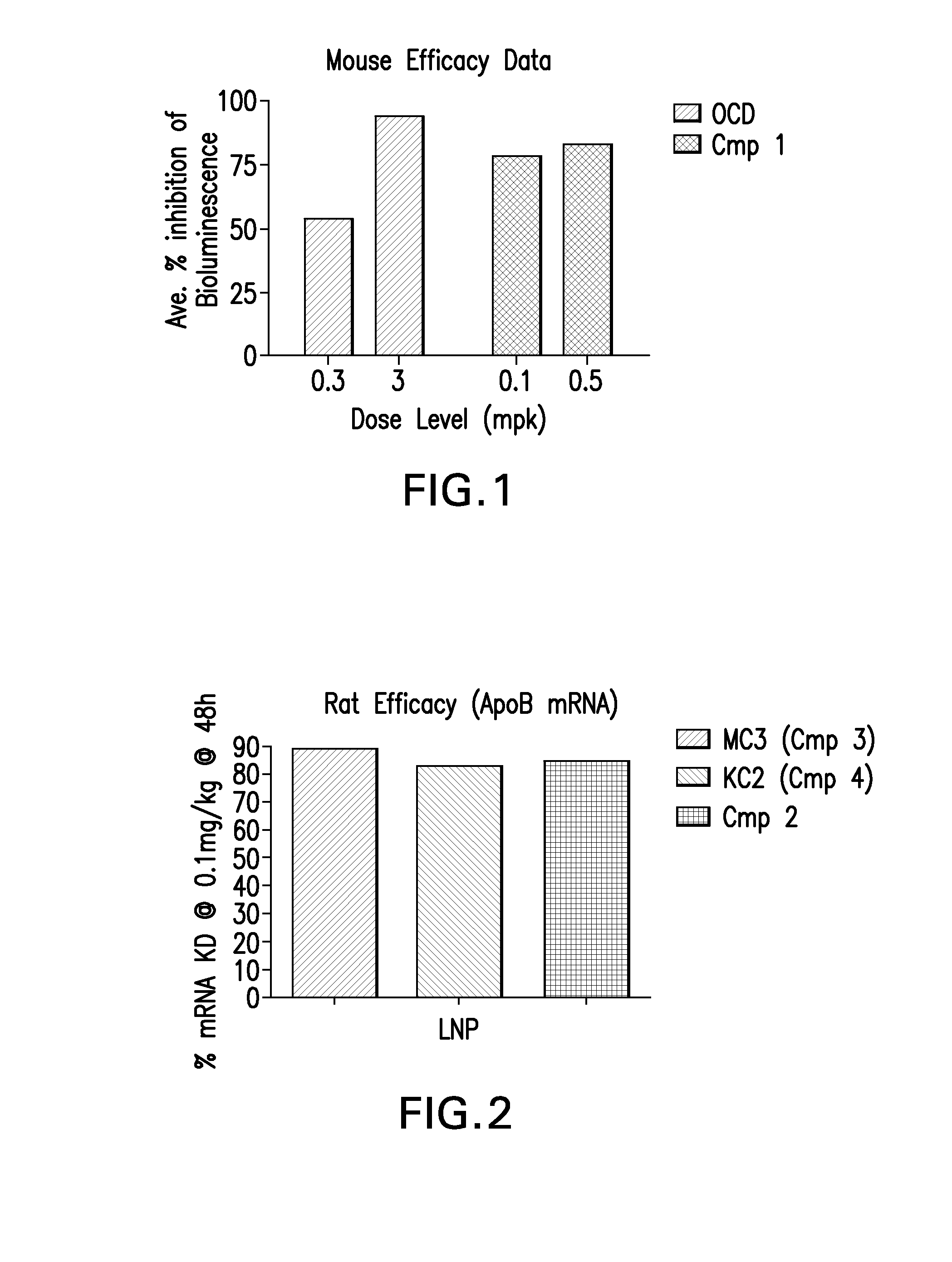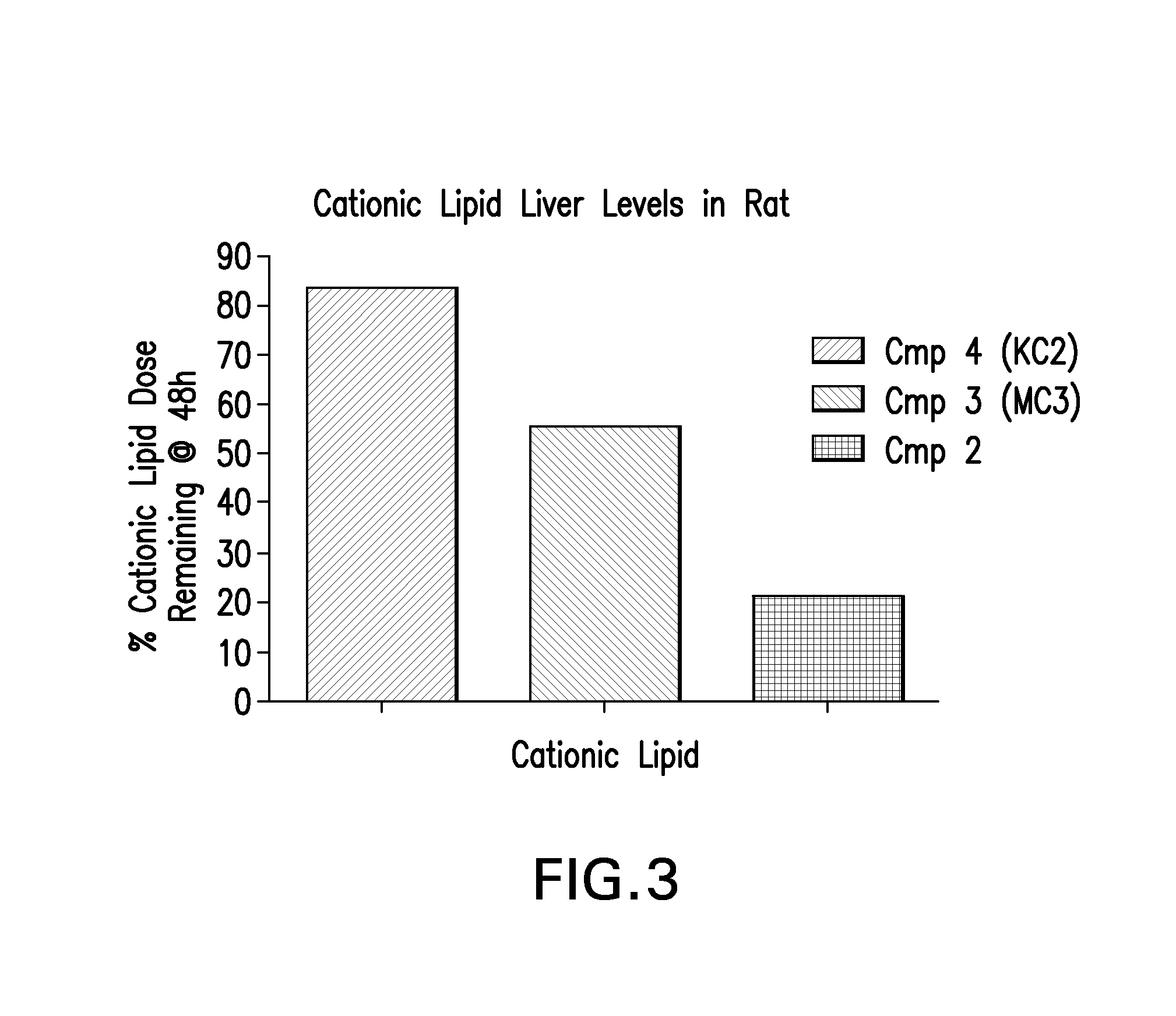Novel Low Molecular Weight Cationic Lipids For Oligonucleotide Delivery
a lipid and oligonucleotide technology, applied in the field of cationic lipids, can solve problems such as non-optimal delivery efficiency, and achieve the effects of reducing liver toxicity, reducing lipid levels in the liver, and improving efficiency
- Summary
- Abstract
- Description
- Claims
- Application Information
AI Technical Summary
Benefits of technology
Problems solved by technology
Method used
Image
Examples
example 1
Mouse In Vivo Evaluation of Efficacy
[0123]LNPs utilizing Compound 1, in the nominal compositions described immediately above, were evaluated for in vivo efficacy. The siRNA targets the mRNA transcript for the firefly (Photinus pyralis) luciferase gene (Accession #M15077). The primary sequence and chemical modification pattern of the luciferase siRNA is displayed above. The in vivo luciferase model employs a transgenic mouse in which the firefly luciferase coding sequence is present in all cells. ROSA26-LoxP-Stop-LoxP-Luc (LSL-Luc) transgenic mice licensed from the Dana Farber Cancer Institute are induced to express the Luciferase gene by first removing the LSL sequence with a recombinant Ad-Cre virus (Vector Biolabs). Due to the organo-tropic nature of the virus, expression is limited to the liver when delivered via tail vein injection. Luciferase expression levels in liver are quantitated by measuring light output, using an IVIS imager (Xenogen) following administration of the luci...
example 2
Rat In Vivo Evaluation of Efficacy and Toxicity
[0124]LNPs utilizing compounds in the nominal compositions described above, were evaluated for in vivo efficacy and increases in alanine amino transferase and aspartate amino transferase in Sprague-Dawley (Crl:CD(SD) female rats (Charles River Labs). The siRNA targets the mRNA transcript for the ApoB gene (Accession #NM 019287). The primary sequence and chemical modification pattern of the ApoB siRNA is displayed above. The RDVs (containing siRNA) in PBS vehicle were tail vein injected in a volume of 1 to 1.5 mL. Infusion rate is approximately 3 ml / min. Five rats were used in each dosing group. After LNP administration, rats are placed in cages with normal diet and water present. Six hours post dose, food is removed from the cages. Animal necropsy is performed 24 hours after LNP dosing. Rats are anesthetized under isoflurane for 5 minutes, then maintained under anesthesia by placing them in nose cones continuing the delivery of isoflura...
example 3
Determination of Cationic Lipid Levels in Rat Liver
[0125]Liver tissue was weighed into 20-ml vials and homogenized in 9 v / w of water using a GenoGrinder 2000 (OPS Diagnostics, 1600 strokes / min, 5 min). A 50 μL aliquot of each tissue homogenate was mixed with 300 ∥L of extraction / protein precipitating solvent (50 / 50 acetonitrile / methanol containing 500 nM internal standard) and the plate was centrifuged to sediment precipitated protein. A volume of 200 μL of each supernatant was then transferred to separate wells of a 96-well plate and 10 μl samples were directly analyzed by LC / MS-MS.
[0126]Standards were prepared by spiking known amounts of a methanol stock solution of compound into untreated rat liver homogenate (9 vol water / weight liver). Aliquots (50 μL) each standard / liver homogenate was mixed with 300 μL of extraction / protein precipitating solvent (50 / 50 acetonitrile / methanol containing 500 nM internal standard) and the plate was centrifuged to sediment precipitated protein. A v...
PUM
| Property | Measurement | Unit |
|---|---|---|
| Molecular weight | aaaaa | aaaaa |
Abstract
Description
Claims
Application Information
 Login to View More
Login to View More - R&D
- Intellectual Property
- Life Sciences
- Materials
- Tech Scout
- Unparalleled Data Quality
- Higher Quality Content
- 60% Fewer Hallucinations
Browse by: Latest US Patents, China's latest patents, Technical Efficacy Thesaurus, Application Domain, Technology Topic, Popular Technical Reports.
© 2025 PatSnap. All rights reserved.Legal|Privacy policy|Modern Slavery Act Transparency Statement|Sitemap|About US| Contact US: help@patsnap.com



